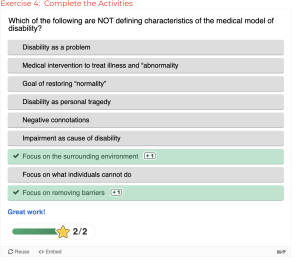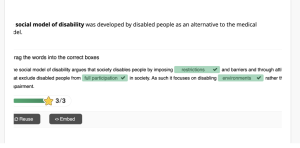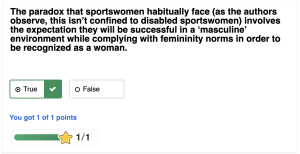5
Section one: The fundamentals
A)
Exercise 1: Notebook Prompt
Many of you are likely familiar with the concept of “ability inequity,” which the authors of this article define as “an unjust or unfair (a) ‘distribution of access to and protection from abilities generated through human interventions’ or (b) ‘judgment of abilities intrinsic to biological structures such as the human body’.”
However, they go on to identify the following “ability concepts” that are less familiar:
1) ability security (one is able to live a decent life with whatever set of abilities one has)
2) ability identity security (to be able to be at ease with ones abilities)
How prevalent are these forms of security among disabled people you know? Or, if you identify as a disabled person, would you say your social surroundings and community foster and support these kinds of security? Furthermore, while the focus of the article is on Kinesiology programs, it is also important to reflect on how academia in general accommodates for disability. If you feel comfortable answering this question, what has been your experience of postsecondary education to date?
-OR-
The authors also observe that “Ableism not only intersects with other forms of oppression, such as racism, sexism, ageism, and classism, but abilities are often used to justify such negative ‘isms’.”
What do you think this means? Provide an example.
|
This comment suggests that ableism can work in correlation to other forms of oppression, such as racism, sexism, ageism, and classism. Therefore, ableism does not exists alone; it often works in existence with others. Additionally, people may use others’ abilities to justify other discriminatory treatment like racism or sexism. For example, a young girl may face both ageism and sexism in a workplace because of the perception from society that women are not capable of holding power, especially young women. I have experienced this exact scenario in my workplace. I have approached costumers to provide them with help, and they ask for a man to help them even though I know just as much as my male coworkers. |
Exercise 2: Implicit Bias Test
Did anything surprise you about the results of the test? Please share if you’re comfortable OR comment on the usefulness of these kinds of tests more generally.
| I believe the Harvard Implicit Bias Test (Ableism) is useful as it allows for biases to be revealed that individuals may or may not know they have, helping raise awareness around people with disabilities and ableism. The test pointed out ideas to me that I did not realize I had, which overall helped me be aware of my unconsciousness. |
B) Keywords
Exercise 3:
Add the keyword you contributed to padlet and briefly (50 words max) explain its importance to you.
|
The social model of disability refers to the person being disabled by their environment and its physical, attitudinal, communication, and social barriers. Additionally, disabled people are normal, valid varieties of human being and should have equal rights and access to society, just as they are. Since the disabled person is inherently equal, they have a right to autonomy, choice, and free and informed consent I their own lives. |
B) On Disability
Exercise 4: Complete the Activities



Exercise 5: Notebook Prompt
What do Fitzgerald and Long identify as barriers to inclusion and how might these apply to sport in particular?
Fitzgerald and Long identify several barriers to inclusion such as race, gender, and ethnicity discrimination, disability, sexual orientation, religion and class. Looking at physical barriers, people with disabilities in sport often face difficulties in sport with a lack of accessibility to meet their needs. For example, not having ramps or other structures that are needed are barriers that affect their participation in sport.
C) Inclusion, Integration, Separation
Exercise 6: Complete the Activities

Exercise 7: Notebook Prompt
Choose ONE of the three questions Fitzgerald and Long argue disability sport needs to address and record your thoughts in your Notebook.
- Should sport be grouped by ability or disability?
- Is sport for participation or competition?
- Should sport competitions be integrated?
|
2. Is sport for participation or competition?
I believe sport can be for both participation and competition, that is why there are different levels. Some people play sports for fun and leisure however, others play for the competitiveness and take it more seriously. I think it’s a good thing that there are different levels because then this allows for less conflict when some people are playing sports for a different reason than others. Some people play sports strictly to stay fit and just for participation however, for others its their whole world and are there for the competeition. |
Part Two: Making Connections
A) Gender, Sport and Disability

Exercise 8: Complete the Activity
The paradox that sportswomen habitually face (as the authors observe, this isn’t confined to disabled sportswomen) involves the expectation they will be successful in a ‘masculine’ environment while complying with femininity norms in order to be recognized as a woman.
True or false?
Take a moment to reflect on this paradox below (optional).
B) Masculinity, Disability, and Murderball
Exercise 9: Notebook/Padlet Prompt
Watch the film, Murderball and respond to the question in the padlet below (you will have an opportunity to return to the film at the end of this module).
The authors of “Cripping Sport and Physical Activity: An Intersectional Approach to Gender and Disability” observe that the “gendered performance of the wheelchair rugby players can…be interpreted as a form of resistance to marginalized masculinity” (332) but also point out that it may reinforce “ableist norms of masculinity.” After viewing the film, which argument do you agree with?
a) Murderball celebrates a kind of resistance to marginalized masculinity
| I would choose A) Murderball celebrates a kind of resistance to marginalized masculinity. The film challenges stereotypes of disabled men as being weak because it shows their competitiveness, strength, and resilience. Additionally, murderball allows the men to express their physicality, which challenges the negative stereotypes surrounding disabled people, which typically views them as less capable. Overall, the film is a good way to change society’s perception and biases surrounding disabled individuals. |
Section Three: Taking a Shot
A) Resistance
B) Calling out Supercrip
Exercise 10: Mini Assignment (worth 5% in addition to the module grade)
1) Do you agree with the critique of the “supercrip” narrative in this video? Why or why not? Find an example of the “supercrip” Paralympian in the 2024 Paris Paralympics or Special Olympics coverage and explain how it works.
| Yes, I agree with the criticism of the “supercrip” storyline in this video. Although the “supercrip” narrative can reflect light on athletes with disabilities, encourage others, and recognize their achievements, it also has significant drawbacks. To me, this story does not accurately reflect these athletes’ accomplishments. It’s almost as if people have unreasonable expectations for impaired athletes, and when they succeed, it makes it appear as if they can’t do it, which is why they’re instantly acknowledged. During the Paralympics, popular judoka Teddy Riner referred to prominent Paralympians as “superheroes” and “Avengers.” In response, French wheelchair basketball player Sofyane Mehiaoui stated, “We are people with disabilities, and we want to be considered normal people.” “We are not superheroes, but athletes.” This is an example of the “supercrip” narrative, in which people describe disabled athletes as “superheroes” due to their disability while failing to recognize their true aptitude and abilities. |
2) Does the film Murderball play into the supercrip narrative in your opinion? How does gender inform supercrip (read this blog for some ideas)?
(300 words for each response)
| I believe the film Murderball fits into the supercrip concept. This narrative sheds a lot of insight on athletes and how they overcame disabilities to achieve their goals. However, the Murderball film depicts a different dynamic. Instead, it focuses on the athletes’ actual experiences, emphasizing their talent, strength, and competition without portraying them as victims or heroes. The film does not require the athletes to explain constantly how their disability affects their lives or define their identity through it. Instead, their experiences are told in the same manner that an able-bodied athlete’s story would be, with a focus on sport, passion, and personality. This makes their portrayal seem more genuine and respectful.
|


Feedback/Errata